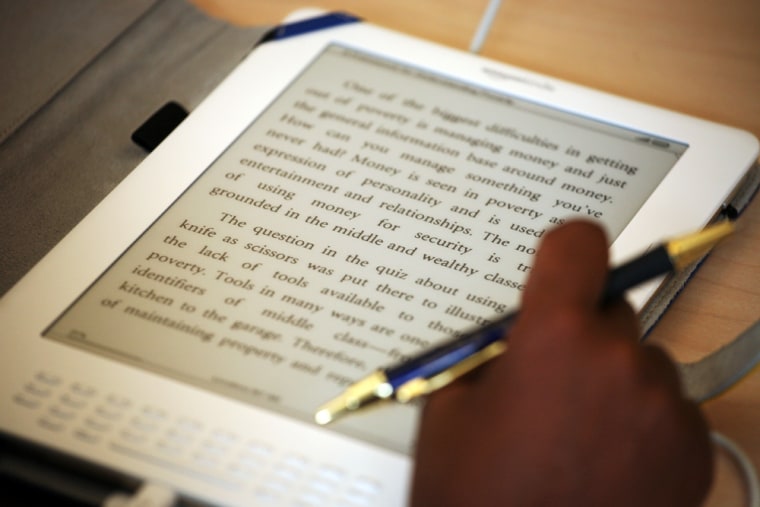Each semester, the same scenes play out at collegiate bookstores across the country: long lines, arcane return policies, exorbitantly priced sweatshirts, overeager freshman, and textbooks whose prices add up to more than a typical monthly car payment.
Shopping-savvy students increasingly are avoiding the traffic jam and lessening the sticker shock by choosing to rent or purchase used textbooks online. But as a generation heads to school armed with multiple mobile devices, publishers are beginning to offer digital alternatives to traditional course materials.
Proponents of digital textbooks (or e-textbooks) tout their lower cost, instant accessibility, ecological sense, and potential to transform how students interact with course materials. Not to mention the fact that e-textbooks mean the end of backpacks heavier than a sack of bricks.
A complicated format
Nevertheless, while ordinary e-books are catching on like wildfire — Amazon reported that in July Kindle e-books outsold hardcover books — e-textbooks are not yet pervasive at traditional universities.
The medium presents a unique set of problems. "Textbooks are the most complex e-book that there is out there, with everything from pagination, notation, searching and indexing, copy/paste, the ability to post to social media, and then multimedia like video, audio, pictures, and slideshows … An e-textbook has to put them all in one package and do them well," says Josh Koppel, whose company, ScrollMotion, is working with publishers to bring texts to the iPad.
In a recently released study, the National Association of College Stores found that digital textbooks account for just 2 to 3 percent of sales at member stores.
Part of the difficulty is that "in the higher education market, users' needs are so unique that all the right pieces haven't come into place yet," says Tracey Weber, executive vice president of textbooks and digital education for Barnes & Noble. "Publishers, faculty, and students each have a separate set of demands for what an e-textbook should be able to do."
Publishers, for their part, have to contend with the tricky realm of digital rights management (DRM) and strike a delicate balance between protecting copyrights and giving students adequate access for studying effectively. Common restrictions limit the number of devices that the e-textbook can be read on and how much of the text can be printed, shared, and copied/pasted.
Furthermore, though today's students may be tech-centric, they grew up learning from printed materials. Many find it tiring to read on a digital screen for long periods of time, or dislike the limitations of the applications used to read materials.
One well-documented example is Amazon's Kindle DX pilot trial program. Students at seven universities (including Princeton and the University of Virginia) used the first-generation Kindle DX in place of traditional textbooks and then reported on the classroom effectiveness of the 9.7-inch e-book reader.
The results were underwhelming, as many (though by no means all) students found that the device didn't suit their study habits. Common complaints included difficulty in using the keyboard to take notes, frustration at not being able to view multiple texts at once, and the cumbersomeness of moving back and forth through the pages.
Burgeoning innovation
The benefits of going paperless — and predictions that e-textbooks will comprise 10 to 15 percent of the market in 2012 (and steadily climb upward thereafter) — have prompted a slew of new ventures from giants like Barnes & Noble and from small start-ups. Each such effort attempts to address the rapidly changing needs of students and the array of challenges currently hampering widespread adoption of e-textbooks.
Many publishers offer digital titles directly through their own e-bookstores. But because each uses its own format (and because students are unlikely to obtain all of their textbooks from the same place), students must download and use several software applications to read all of the texts. To make e-textbooks as widely available as possible,publishers also offer their titles in a number of different marketplaces.
CourseSmart, a venture founded in 2007 by six higher-education textbook publishers, is one of the market's biggest players, with more than 12,500 titles available by subscription. Book-selling giant Barnes & Noble is making strides in the market with a new software application, Nookstudy, for accessing e-textbooks from its catalog and for integrating with the popular course management software, Blackboard. Not to be left out, Amazon has made e-textbook titles available on its Kindle e-readers and on PCs, as well as through Kindle applications on mobile devices (iPad, Android, Blackberry, iPhone).
Other companies offer e-texts on platforms that have unique features. CaféScribe, for example, added a social networking component to its software to help students form study groups and share notes. VitalSource offers a flexible approach to accessing texts, allowing users to study on a mobile device, from a downloaded copy, or through any Internet-connected computer. Entourage took a hardware-specific approach, building the dual-screen Edge e-reader to address students' special studying needs.
The where-to-buy question remains one of the biggest, given that digital textbooks are tied to a specific platform and format. The marketplace where you purchase the text will determine the hardware and software you can use to access it.
If your titles are available in more than one marketplace, the key factors to consider are price, whether you want to own or rent the text, which devices you can access the content from, and which e-reader software application best suits your studying habits. Stay tuned for our upcoming feature focusing on where to buy e-textbooks.
